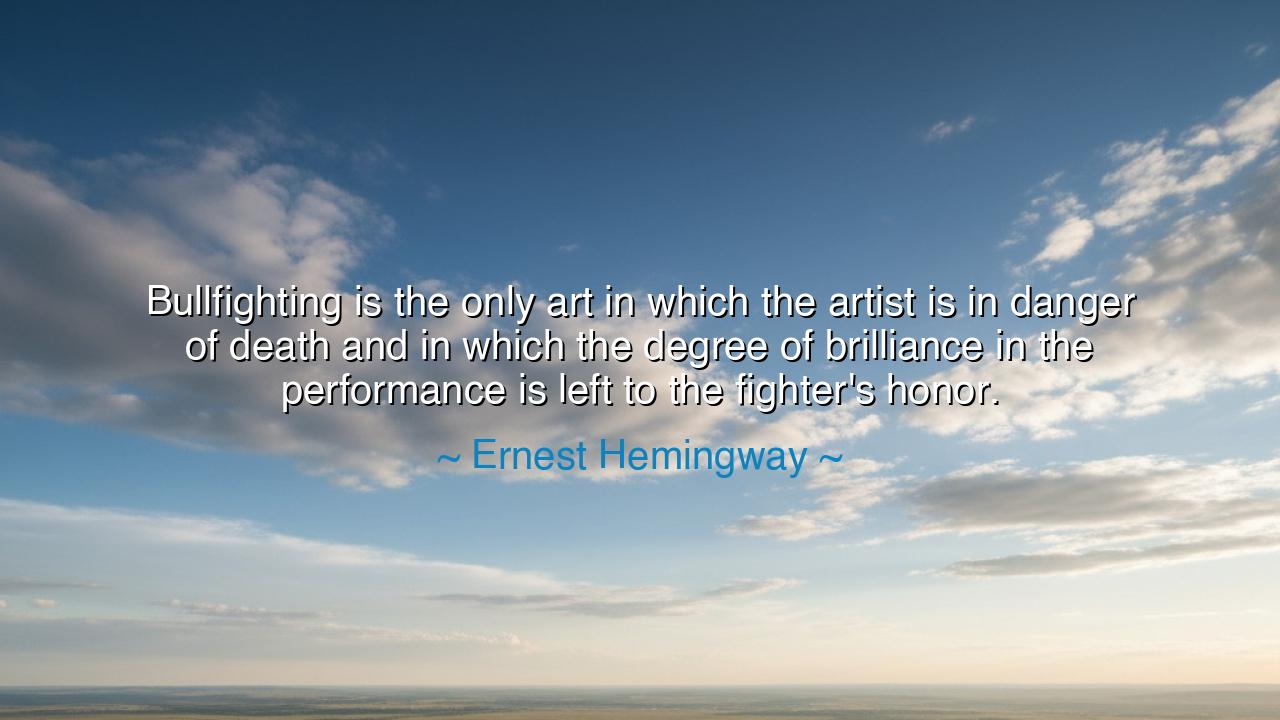
Bullfighting is the only art in which the artist is in danger of
Bullfighting is the only art in which the artist is in danger of death and in which the degree of brilliance in the performance is left to the fighter's honor.






“Bullfighting is the only art in which the artist is in danger of death and in which the degree of brilliance in the performance is left to the fighter’s honor.” So spoke Ernest Hemingway, the chronicler of courage and the poet of danger. In these words, he revealed his deepest fascination with the art of the bullfight — that ancient, blood-red dance between man and beast. To him, bullfighting was not mere sport, nor spectacle; it was a ceremony of truth, a ritual where beauty, death, and honor met face to face. For Hemingway, who sought meaning in the tension between life and mortality, the bullring was the stage upon which the human spirit showed its purest form — stripped of pretense, governed only by courage.
In the corrida, there is no hiding. The matador stands before a creature of power and instinct, and in that circle of sand, the illusion of safety is destroyed. Every movement is a prayer against death; every flourish of the cape is an act of defiance. Hemingway called it an art because it demanded more than skill — it demanded soul. The matador’s grace, timing, and poise transform violence into beauty. Yet it is not beauty without consequence: a single error means death. Unlike the painter who may paint again, or the poet who may rewrite his verse, the bullfighter’s mistake is paid in blood. Thus, this art alone holds the artist in danger, body and spirit bound to the price of their creation.
The heart of Hemingway’s quote lies in one word — honor. For in the bullring, no referee dictates how far the fighter must go. The brilliance of the performance depends upon the matador’s own courage, upon his willingness to stand closer, to risk more, to face the beast not with cruelty but with composure. Honor is the measure of his art. Some may seek safety and survive; others seek glory and transcend. And therein lies the ancient question that echoes through all human endeavor: how much of ourselves are we willing to give to our craft, our calling, our truth?
This idea of risking everything for beauty is not confined to the bullring. It is the same spirit that drove the samurai of old Japan, who believed that art and death were brothers — that the way of the sword was also the way of grace. It is the fire that moved the sculptor Michelangelo, who carved his David not to please patrons but to defy imperfection itself, chiseling until his hands bled. It is the devotion of the soldier who fights not for glory, but for duty; the writer who writes knowing his words may destroy him; the lover who loves though heartbreak awaits. Each of these souls, like the matador, faces their bull — their test — and their honor determines the brilliance of their performance.
Hemingway himself lived by this creed. He wrote as the bullfighter fought — close to death, close to truth. His life was a series of battles against fear, despair, and silence. He hunted, he climbed, he went to war, not out of recklessness but in pursuit of authenticity. He believed that a man reveals himself most truly when facing death, for in that moment, all lies fall away. The bullfight, to him, symbolized this eternal struggle — the confrontation between mortal fragility and immortal courage. The matador, calm before danger, embodied the grace Hemingway sought in his own art: to face life’s violence and still make it beautiful.
Yet, his words also carry a warning. For the artist who risks nothing may live safely, but their work will lack soul. The bullfighter who stays far from the horns may leave the arena unscathed — but unremembered. To live honorably, to create something of worth, is to stand within reach of the horns, trembling but unbroken. Life’s greatest art is lived at that edge, where safety ends and meaning begins.
Lesson: Seek not a life without danger, but a life worthy of danger. Let your work, your love, your purpose demand something of you — your time, your fear, your comfort. Do not mistake caution for wisdom, nor risk for folly. For as Hemingway taught, the measure of your art, whatever form it takes, is found in your honor — in how deeply you dare to engage with what could destroy you, and still make it beautiful.
So stand, as the matador stands: still, composed, and resolute before the charging bull of fate. For though death is certain, how you meet it — with fear or with brilliance — is the art by which your life will be remembered.






AAdministratorAdministrator
Welcome, honored guests. Please leave a comment, we will respond soon